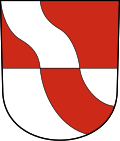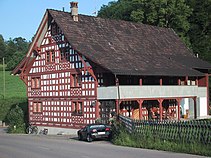Kradolf-Schönenberg
| Kradolf-Schönenberg | |
|---|---|
| State : |
|
| Canton : |
|
| District : | Weinfelden |
| BFS no. : | 4501 |
| Postal code : | 9214 Kradolf 9215 Buhwil 9215 Schönenberg an der Thur 9217 Neukirch an der Thur |
| Coordinates : | 731 408 / 264 341 |
| Height : | 455 m above sea level M. |
| Height range : | 437–642 m above sea level M. |
| Area : | 10.95 km² |
| Residents: | 3592 (December 31, 2018) |
| Population density : | 328 inhabitants per km² |
| Website: | www.kradolf-schoenenberg.ch |
| Location of the municipality | |
Kradolf-Schönenberg , in the Swiss German local dialect Chraaleff-Schönebèrg [ χrɑːləfː-ʃønəbɛrg ] , has been a municipality in the Weinfelden district of the canton of Thurgau , Switzerland , since January 1, 1996 . It consists of the villages and former local communities Buhwil , Kradolf , Neukirch an der Thur and Schönenberg an der Thur .
history

The localities in today's municipal area were first mentioned in the 9th century, Kradolf as in Chreinthorf (883) and Schönenberg as Thuruftisthorf (838). The interpretation of the former is uncertain; Kradolf could mean "Krähendorf" or "Dorf des Grawo". Schönenberg was actually the name of today's castle Last; the original Thuruftisthorf means "village of the Thuruft".
The history of the community of Kradolf-Schönenberg begins in 1991 with consultative votes in the individual local communities about a reorganization of the community structures. Even then it became clear that the two neighboring villages of Schönenberg an der Thur and Kradolf would like to unite. The merger had to wait, however, because the local communities Halden , Schweizersholz , Neukirch an der Thur and Buhwil were having a hard time with their political future. Eventually Halden and Schweizersholz decided to join Bischofszell and Neukirch and Buhwil for the union with Kradolf and Schönenberg. The voters of Kradolf struggled with this decision and only approved the formation of the political community Kradolf-Schönenberg after an intensive referendum campaign in February 1995. On 1 January 1996, then separated from the Munizipalgemeinde Sulgen local church Kradolf and the Munizipalgemeinde Neukirch an der Thur belonging to local churches Buhwil, Neukirch an der Thur and Schoenberg at the Thur and the local church united Schweizersholz separate districts load hose pipes , Störenhaus and Alt Weingarten to the political community Kradolf-Schönenberg.
History of the individual villages
→ See the history sections in the articles Buhwil , Kradolf , Neukirch an der Thur and Schönenberg an der Thur
coat of arms
Blazon : Divided by red and white, covered with a wavy sloping beam in alternating colors.
After the political community Kradolf-Schönenberg was established in 1996, the community assembly established the newly created community coat of arms, which is based on the former local community coat of arms of Kradolf and Schönenberg.
The coat of arms of Kradolf-Schönenberg is similar to that of the municipality of Niedererlinsbach in the canton of Solothurn.
population
 |
| year | 2000 | 2010 | 2018 |
| Residents | 3062 | 3288 | 3584 |
Of the total of 3584 inhabitants in the municipality of Kradolf-Schönenberg in 2018, 842 or 23.5% were foreign nationals. 1242 (34.7%) were Protestant Reformed and 888 (24.8%) were Roman Catholic. The village of Buhwil had 327 residents at that time.
economy
In 2016, Kradolf-Schönenberg offered 847 jobs (converted to full-time positions). 7.7% of them worked in agriculture and forestry, 46.4% in industry, trade and construction and 45.9% in the service sector.
Culture
Kradolf is the goal of the Mammutt raft race on Sitter and Thur , which starts on Mother's Day or on the alternative date one Sunday later in Degenau and in which around 40 teams participate in the three categories of racing class, originality class and fun class every year. The fins often take up current affairs from politics or society and, when the weather is nice, attract between 20,000 and 30,000 visitors. The mammoth raft race has been on the list of living traditions in Switzerland since 2018 .
Personalities
→ see sections Personalities in the articles Kradolf and Neukirch an der Thur
Attractions
The sights of the community include the ruins that have been preserved in two of the villages, namely the ruins of Last and Heuberg in Schönenberg and the ruins of Anwil in Buhwil. Also of historical importance are the various restored (water) mills, which before the beginning of industrialization (silk weaving in Schönenberg from 1863) focused on the cultivation of grain. The power center of the silk weaving mill can still be visited today, which is an industrial monument and at the same time the most important and most complete facility of its kind in Switzerland.
→ see also the Sights section in the article Schweizersholz
→ see also the list of cultural assets in Kradolf-Schönenberg
Web links
Individual evidence
- ↑ Permanent and non-permanent resident population by year, canton, district, municipality, population type and gender (permanent resident population). In: bfs. admin.ch . Federal Statistical Office (FSO), August 31, 2019, accessed on December 22, 2019 .
- ↑ a b Thurgau in figures 2019 . On the website of the Statistical Office of the Canton of Thurgau (PDF file; 1.8 MB), accessed on April 28, 2020.
- ↑ a b Lexicon of Swiss municipality names . Edited by the Center de Dialectologie at the University of Neuchâtel under the direction of Andres Kristol. Frauenfeld / Lausanne 2005, p. 487 f.
- ↑ StiASG , Urk. II 145. Online at e-chartae , accessed on June 25, 2020.
- ^ History. On the website of the municipality of Kradolf-Schönenberg, accessed on November 18, 2019
- ↑ a b c population development of the municipalities. Canton Thurgau, 1850–2000 and resident population of the municipalities and change from the previous year. Canton of Thurgau, 1990–2018. On the website of the Statistical Office of the Canton of Thurgau (Excel tables; 0.1 MB each), accessed on April 28, 2020.
- ↑ a b municipal coat of arms . On the website of the State Archives of the Canton of Thurgau, accessed on December 8, 2019
- ↑ Localities and their resident population. Edition 2019 . On the website of the Statistical Office of the Canton of Thurgau (Excel table; 0.1 MB), accessed on April 28, 2020.
- ↑ Mammut raft races are new on the "Living Traditions of Switzerland" list. On: St. Galler Tagblatt (online) from June 28, 2018








